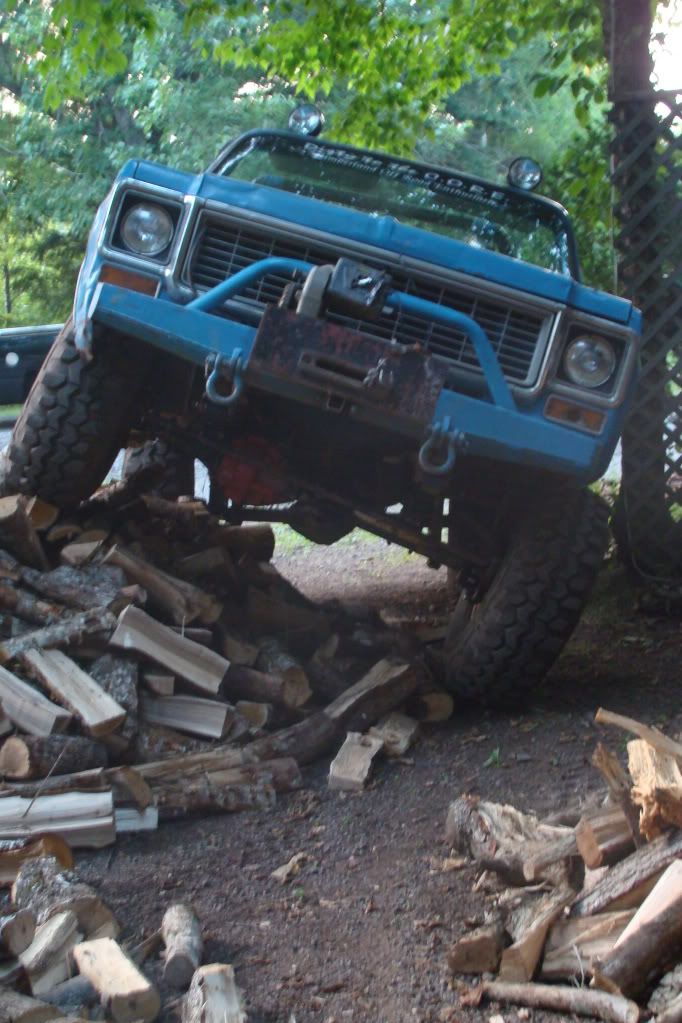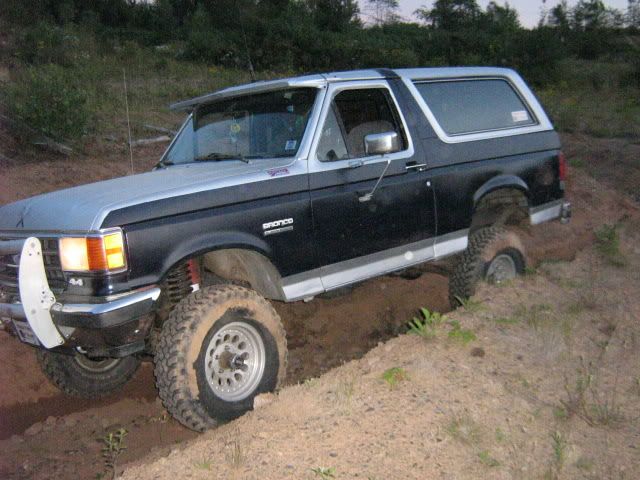Post by luvmyjeep on Jan 14, 2010 19:00:17 GMT -4
I came across this article on the web. It's about airing down for sand wheeling, but the principle is the same.
Why Low Pressure Works
It’s a simple fact, which some diehards still deny, the bigger the footprint, the softer the stuff you can travel. Mother Nature knows it. Take a look at the feet of camels, polar bears and marsh birds. They are big and spread out to distribute their weight over a larger surface area. For those who say skinny, hard tires are better for snow, mud or whatever, please tell me why they don’t use ten-speed bicycle-type tires on snowmobiles? Sand rail people and mud boggers know big feet work better too!

Four Affects of Low Tire Pressure
Low tire pressure changes four things: footprint; ground clearance; rolling radius and what I call Obstacle Rolling Resistance. Common sense and the TREAD FOOTPRINT figure shows the center of the axle is lowered by the decrease in wheel height. This results in lower ground clearance and consider the softer tires also flex and give more resulting in compression loss of ground clearance too. But on the other hand, ground clearance is not that important in the sand.
Rolling radius is part of the equation which contributes to your net moving force; your overall gear ratio; your "stump pullin’ power". Think of it this way: you know how bigger tires eat up low gearing and smaller tires effectively give you lower gears? Flatter tires act like smaller tires and increase your pulling (moving) power.
OBSTACLE ROLLING RESISTANCE
Move on to the OBSTACLE ROLLING RESISTANCE figure below to learn how significant this sleeper is! Several years back, I was convinced a tire’s ability to conform to obstacles played a big part in ease of movement, but I had no idea how significant it was until I measured it. Here’s my experiment.

Face-off two 4Xs some 30 feet apart, on a flat, smooth surface. Take the winch of one and connect it to the other, with a dynamometer (a big fish scale) in the cable. Put a pair of 2X4 wood blocks in front of the pulled vehicle and measure the force (pull) required for different towed vehicle tire pressures.
A simple, lowly 2X4 offers more of a climb angle (hill) than you might initially think. It is roughly 25° to 30°. Knowing this, it’s now easy to see why not so big rocks require the thrash and bash technique to climb with hard tires.
The 2X4 tests showed a 40% difference between street and sand pressure! And it may be worse than that because the initial burst of pull required to get the street pressure tires started up over the obstacles (the 2X4s) was not precisely recordable with my crude equipment and test methods. With the sand tire-pressure, it was obvious the dynamometer saw a gradual buildup in force as the tires smoothly conformed and crawled over the obstacles. What this 40% difference means is you now have roughly six tires where you only had four. Add this to the "ten tires" of the pressure drop and you now have 16 where you had four. Any more questions about the effectiveness of lowering tire pressure?
There is a lot more to making this test perfect and I would be most happy to redo it using proper equipment and controls. Anyone have access to strain gauge cells and strip chart recorders?
Rock Crawling
Actually, I suspect this is also why lower tire pressure is very effective for rock crawling. The Obstacle Rolling Resistance factor, as I call it, plays an even more crucial role when rolling through the rocks.
Caution!
Now comes the soap box. Use Caution! Caution! Caution! with low tire pressure. The Obstacle Rolling Resistance factor works against you with speed and in the rocks! Soft tires easily bend and break wheels. Drive with caution when back on hard ground or the rocks! And you obviously need some way to reinflate the tires back to street pressure when you hit the black stuff.
Even in 2WD
You 2-wheelers take note as well, for this trick works equally well in 2WD. But remember, you must still deflate all four tires even though you are only putting power to two. Your hard front tires create hills that your rears must continually try to climb.
Treading Lightly
I also feel lower pressure is more ecologically compatible. With better traction you don’t have to spin the tires and hence leave Mother Nature unscathed.
You’ll be doing yourself and Mother Nature a favor when you lower your tire pressure the next time you hit the soft stuff.
© Harry Lewellyn
Why Low Pressure Works
It’s a simple fact, which some diehards still deny, the bigger the footprint, the softer the stuff you can travel. Mother Nature knows it. Take a look at the feet of camels, polar bears and marsh birds. They are big and spread out to distribute their weight over a larger surface area. For those who say skinny, hard tires are better for snow, mud or whatever, please tell me why they don’t use ten-speed bicycle-type tires on snowmobiles? Sand rail people and mud boggers know big feet work better too!

Four Affects of Low Tire Pressure
Low tire pressure changes four things: footprint; ground clearance; rolling radius and what I call Obstacle Rolling Resistance. Common sense and the TREAD FOOTPRINT figure shows the center of the axle is lowered by the decrease in wheel height. This results in lower ground clearance and consider the softer tires also flex and give more resulting in compression loss of ground clearance too. But on the other hand, ground clearance is not that important in the sand.
Rolling radius is part of the equation which contributes to your net moving force; your overall gear ratio; your "stump pullin’ power". Think of it this way: you know how bigger tires eat up low gearing and smaller tires effectively give you lower gears? Flatter tires act like smaller tires and increase your pulling (moving) power.
OBSTACLE ROLLING RESISTANCE
Move on to the OBSTACLE ROLLING RESISTANCE figure below to learn how significant this sleeper is! Several years back, I was convinced a tire’s ability to conform to obstacles played a big part in ease of movement, but I had no idea how significant it was until I measured it. Here’s my experiment.

Face-off two 4Xs some 30 feet apart, on a flat, smooth surface. Take the winch of one and connect it to the other, with a dynamometer (a big fish scale) in the cable. Put a pair of 2X4 wood blocks in front of the pulled vehicle and measure the force (pull) required for different towed vehicle tire pressures.
A simple, lowly 2X4 offers more of a climb angle (hill) than you might initially think. It is roughly 25° to 30°. Knowing this, it’s now easy to see why not so big rocks require the thrash and bash technique to climb with hard tires.
The 2X4 tests showed a 40% difference between street and sand pressure! And it may be worse than that because the initial burst of pull required to get the street pressure tires started up over the obstacles (the 2X4s) was not precisely recordable with my crude equipment and test methods. With the sand tire-pressure, it was obvious the dynamometer saw a gradual buildup in force as the tires smoothly conformed and crawled over the obstacles. What this 40% difference means is you now have roughly six tires where you only had four. Add this to the "ten tires" of the pressure drop and you now have 16 where you had four. Any more questions about the effectiveness of lowering tire pressure?
There is a lot more to making this test perfect and I would be most happy to redo it using proper equipment and controls. Anyone have access to strain gauge cells and strip chart recorders?
Rock Crawling
Actually, I suspect this is also why lower tire pressure is very effective for rock crawling. The Obstacle Rolling Resistance factor, as I call it, plays an even more crucial role when rolling through the rocks.
Caution!
Now comes the soap box. Use Caution! Caution! Caution! with low tire pressure. The Obstacle Rolling Resistance factor works against you with speed and in the rocks! Soft tires easily bend and break wheels. Drive with caution when back on hard ground or the rocks! And you obviously need some way to reinflate the tires back to street pressure when you hit the black stuff.
Even in 2WD
You 2-wheelers take note as well, for this trick works equally well in 2WD. But remember, you must still deflate all four tires even though you are only putting power to two. Your hard front tires create hills that your rears must continually try to climb.
Treading Lightly
I also feel lower pressure is more ecologically compatible. With better traction you don’t have to spin the tires and hence leave Mother Nature unscathed.
You’ll be doing yourself and Mother Nature a favor when you lower your tire pressure the next time you hit the soft stuff.
© Harry Lewellyn




 and people say that i have too much time on my hands.just kidding,interesting.
and people say that i have too much time on my hands.just kidding,interesting. 




